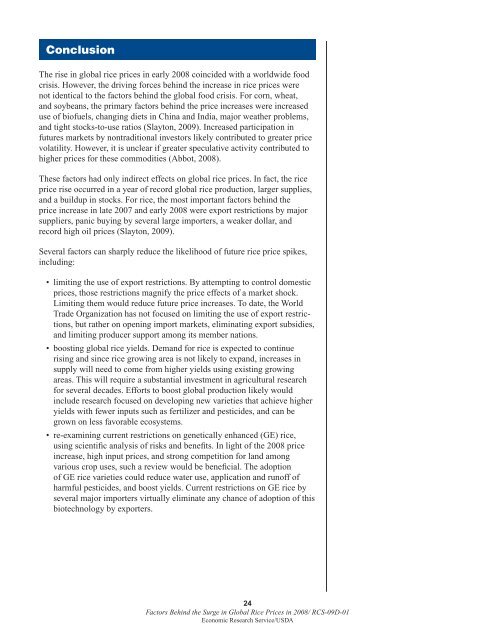Childs et al. - 2009 - Factors behind the rise in global rice prices in 2
Childs et al. - 2009 - Factors behind the rise in global rice prices in 2
Childs et al. - 2009 - Factors behind the rise in global rice prices in 2
Create successful ePaper yourself
Turn your PDF publications into a flip-book with our unique Google optimized e-Paper software.
Conclusion<br />
The <strong>rise</strong> <strong>in</strong> glob<strong>al</strong> <strong>rice</strong> p<strong>rice</strong>s <strong>in</strong> early 2008 co<strong>in</strong>cided with a worldwide food<br />
crisis. However, <strong>the</strong> driv<strong>in</strong>g forces <strong>beh<strong>in</strong>d</strong> <strong>the</strong> <strong>in</strong>crease <strong>in</strong> <strong>rice</strong> p<strong>rice</strong>s were<br />
not identic<strong>al</strong> to <strong>the</strong> factors <strong>beh<strong>in</strong>d</strong> <strong>the</strong> glob<strong>al</strong> food crisis. For corn, wheat,<br />
and soybeans, <strong>the</strong> primary factors <strong>beh<strong>in</strong>d</strong> <strong>the</strong> p<strong>rice</strong> <strong>in</strong>creases were <strong>in</strong>creased<br />
use of biofuels, chang<strong>in</strong>g di<strong>et</strong>s <strong>in</strong> Ch<strong>in</strong>a and India, major wea<strong>the</strong>r problems,<br />
and tight stocks-to-use ratios (Slayton, <strong>2009</strong>). Increased participation <strong>in</strong><br />
futures mark<strong>et</strong>s by nontradition<strong>al</strong> <strong>in</strong>vestors likely contributed to greater p<strong>rice</strong><br />
volatility. However, it is unclear if greater speculative activity contributed to<br />
higher p<strong>rice</strong>s for <strong>the</strong>se commodities (Abbot, 2008).<br />
These factors had only <strong>in</strong>direct effects on glob<strong>al</strong> <strong>rice</strong> p<strong>rice</strong>s. In fact, <strong>the</strong> <strong>rice</strong><br />
p<strong>rice</strong> <strong>rise</strong> occurred <strong>in</strong> a year of record glob<strong>al</strong> <strong>rice</strong> production, larger supplies,<br />
and a buildup <strong>in</strong> stocks. For <strong>rice</strong>, <strong>the</strong> most important factors <strong>beh<strong>in</strong>d</strong> <strong>the</strong><br />
p<strong>rice</strong> <strong>in</strong>crease <strong>in</strong> late 2007 and early 2008 were export restrictions by major<br />
suppliers, panic buy<strong>in</strong>g by sever<strong>al</strong> large importers, a weaker dollar, and<br />
record high oil p<strong>rice</strong>s (Slayton, <strong>2009</strong>).<br />
Sever<strong>al</strong> factors can sharply reduce <strong>the</strong> likelihood of future <strong>rice</strong> p<strong>rice</strong> spikes,<br />
<strong>in</strong>clud<strong>in</strong>g:<br />
• limit<strong>in</strong>g <strong>the</strong> use of export restrictions. By attempt<strong>in</strong>g to control domestic<br />
p<strong>rice</strong>s, those restrictions magnify <strong>the</strong> p<strong>rice</strong> effects of a mark<strong>et</strong> shock.<br />
Limit<strong>in</strong>g <strong>the</strong>m would reduce future p<strong>rice</strong> <strong>in</strong>creases. To date, <strong>the</strong> World<br />
Trade Organization has not focused on limit<strong>in</strong>g <strong>the</strong> use of export restrictions,<br />
but ra<strong>the</strong>r on open<strong>in</strong>g import mark<strong>et</strong>s, elim<strong>in</strong>at<strong>in</strong>g export subsidies,<br />
and limit<strong>in</strong>g producer support among its member nations.<br />
• boost<strong>in</strong>g glob<strong>al</strong> <strong>rice</strong> yields. Demand for <strong>rice</strong> is expected to cont<strong>in</strong>ue<br />
ris<strong>in</strong>g and s<strong>in</strong>ce <strong>rice</strong> grow<strong>in</strong>g area is not likely to expand, <strong>in</strong>creases <strong>in</strong><br />
supply will need to come from higher yields us<strong>in</strong>g exist<strong>in</strong>g grow<strong>in</strong>g<br />
areas. This will require a substanti<strong>al</strong> <strong>in</strong>vestment <strong>in</strong> agricultur<strong>al</strong> research<br />
for sever<strong>al</strong> decades. Efforts to boost glob<strong>al</strong> production likely would<br />
<strong>in</strong>clude research focused on develop<strong>in</strong>g new vari<strong>et</strong>ies that achieve higher<br />
yields with fewer <strong>in</strong>puts such as fertilizer and pesticides, and can be<br />
grown on less favorable ecosystems.<br />
• re-exam<strong>in</strong><strong>in</strong>g current restrictions on gen<strong>et</strong>ic<strong>al</strong>ly enhanced (GE) <strong>rice</strong>,<br />
us<strong>in</strong>g scientific an<strong>al</strong>ysis of risks and benefits. In light of <strong>the</strong> 2008 p<strong>rice</strong><br />
<strong>in</strong>crease, high <strong>in</strong>put p<strong>rice</strong>s, and strong comp<strong>et</strong>ition for land among<br />
various crop uses, such a review would be benefici<strong>al</strong>. The adoption<br />
of GE <strong>rice</strong> vari<strong>et</strong>ies could reduce water use, application and runoff of<br />
harmful pesticides, and boost yields. Current restrictions on GE <strong>rice</strong> by<br />
sever<strong>al</strong> major importers virtu<strong>al</strong>ly elim<strong>in</strong>ate any chance of adoption of this<br />
biotechnology by exporters.<br />
24<br />
<strong>Factors</strong> Beh<strong>in</strong>d <strong>the</strong> Surge <strong>in</strong> Glob<strong>al</strong> Rice P<strong>rice</strong>s <strong>in</strong> 2008/ RCS-09D-01<br />
Economic Research Service/USDA

















